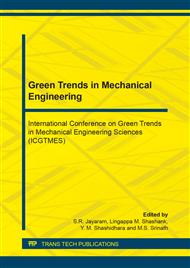p.272
p.278
p.284
p.290
p.295
p.301
p.307
p.313
p.319
Analytical and Finite Element Solution of Tractor Brake Link to Achieve Weight and Cost Reduction
Abstract:
In tractor brakes, when the brake is applied, tension in the operating rod causes the links to turn the two actuating disc slightly, in opposite directions. The shape of the recesses in which the hardened steel balls locate is such that, as disc move relative to each other, the ball force them apart and apply pressure to the rotating discs. The automotive industry has for many years identified weight reduction as a way of improving product competitiveness and thus the ability to make profits. In present work, an attempt has been made to reduce the thickness of link and hence achieve weight reduction and cost savings. The actuator link has been analyzed for stresses. The existing link is of 6 mm thickness and is made of C – 40 steel. The existing link of 6 mm thickness along with links of 5 mm and 4 mm thickness were considered for analysis. It is found that the stresses in 5 mm thick link are well within limits with a factor of safety of 2.3. This reduction in thickness would yield a reduction in weight of link and hence would reduce the cost of link with a saving potential of Rs.14, 40000/= per year considering the fact that 6, 00,000 tractors are sold in India every year. Experimental investigation showed the zone of failure of link is in line with the high stress zone indicated by finite element analysis.
Info:
Periodical:
Pages:
307-312
Citation:
Online since:
November 2019
Authors:
Keywords:
Price:
Сopyright:
© 2019 Trans Tech Publications Ltd. All Rights Reserved
Share:
Citation:


